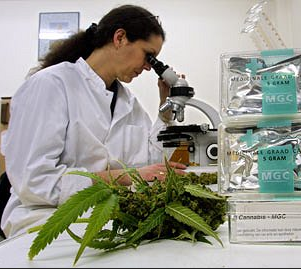August 31, 2014 – The proof of the medical benefits of marijuana remain elusive because  federal law treats cannabis as a Schedule I drug. Along with heroin, it’s in the most dangerous class of drugs with the highest potential for abuse and no “currently accepted” medical use.
federal law treats cannabis as a Schedule I drug. Along with heroin, it’s in the most dangerous class of drugs with the highest potential for abuse and no “currently accepted” medical use.
In contrast, cocaine and methamphetamine are Schedule II drugs.
Federal restrictions hamstring researchers including Nolan Kane, an assistant professor of ecology and evolutionary biology at the University of Colorado in Boulder, who recently began an effort to create the first marijuana genome but is challenged by legal and funding hurdles the federal government has thrown in the way.
The ancient Egyptians and Chinese used cannabis for medicine, as well as paper and rope making, Kane said, and the stock price for GW Pharmaceuticals, a British firm developing a pot-based epilepsy drug, skyrocketed in April after Morgan Stanley backed the company’s business plan.
“People have recognized this as an important medicine for millennia,” Kane said, “and yet we don’t even know how many species of cannabis there are because the work just hasn’t been done.
“People of all ages are using it for different purposes and there certainly is a lot of strong anecdotal evidence, but there haven’t been the kind of medical trials that one would want,” he said.
The Pittsburgh native has studied the genetic makeup of wheat, mustard and chocolate, bok choy, broccoli and kale, and helped develop the genome for sunflowers. His new focus is creating the first complete marijuana genome, in an effort to help find the most effective hybridized forms of marijuana for a variety of practical purposes.
Research money flows very sparingly to the study of marijuana and other drugs considered serious by the federal government, leaving Colorado officials in a bind.
Kane and other researchers interested in studying pot have been unable to get their hands on federal research dollars because marijuana is considered in the same class of drugs as heroin.
“You can get pure cocaine if you want to study cocaine,” Kane said. “You can get pure LSD if you want to study LSD, so there’s been really phenomenally good work by scientists and psychologists and all kinds of people. They’ve begun to understand some of the opiate pathways in our brains.
“Cannabis, you really can’t get access to the same kind of relevant material. There’s only one legal source and the cannabis that’s available, I’ve been told, is essentially irrelevant to the type of work that people want to do.”
The work demanded from the industry involves mostly low-THC research used in the manufacture of industrial hemp and pot-based medicines. The recently passed federal farm bill includes a provision that allows for study of the less mind-altering cannabis varieties, Kane said, but federal law enforcement has been slow to embrace the change. As a result, college officials, so far, have discouraged Kane and others from conducting plant research on the University of Colorado campus.
“The university gave the students permission to organize a scientific conference on cannabis on campus,” he said, “so I think there’s some willingness at the university to move forward with understanding the science and even encouraging some of us to move forward with some of the scientific access in our work. I think this is smart. It’s already a billion-dollar industry and within the next few years it’s projected to be tens of billions of dollars.”
